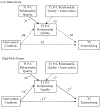Mother-child relationship quality and effective discipline as mediators of the 6-year effects of the New Beginnings Program for children from divorced families
- PMID: 18665687
- PMCID: PMC6112173
- DOI: 10.1037/0022-006X.76.4.579
Mother-child relationship quality and effective discipline as mediators of the 6-year effects of the New Beginnings Program for children from divorced families
Abstract
This study examines whether program effects on mother-child relationship quality and effective discipline mediated the 6-year longitudinal effects of the New Beginnings Program (NBP) to improve mental health and competence outcomes in 218 adolescents from divorced families in a randomized experimental trial. The NBP is a theory-based and parenting-focused preventive intervention to help children adjust to divorce, and it has previously shown significant main and/or Program x Baseline Risk interaction effects to reduce adolescents' mental health and social adaptation problems and to promote competence. Mediation analyses were conducted using single- and two-group (high and low baseline risk) structural equation modeling. A multiple-methods and multiple-informants approach was used to assess the putative mediators and adolescents' outcomes. Results indicated that program-induced improvement in maternal effective discipline at posttest mediated the intervention effect on adolescents' GPA at the 6-year follow-up. Moreover, program-induced improvement in mother-child relationship quality mediated the intervention effect on adolescents' mental health problems for those with high baseline risk for maladjustment. The discussion focuses on the implications of the mediation findings for advancing the developmental theories that informed the design of the NBP and the implications for implementation of the NBP in community settings.
Copyright 2008 APA, all rights reserved.
Figures





References
-
- Achenbach TM (1991). Manual for the Child Behavior Checklist/4–18 and 1991 Profile. Burlington: University of Vermont, Department of Psychology.
-
- Aiken LS, & West SG (1991). Multiple regression: Testing and interpreting interactions. Newbury Park, CA: Sage.
-
- Amato PR, & Keith B (1991). Parental divorce and the well-being of children: A meta-analysis. Psychological Bulletin, 110, 26–46. - PubMed
-
- Astone NM, & McLanahan SS (1991). Family structure, parental practices and high school completion. American Sociological Review, 56, 309–320.
-
- Barnes H, & Olson DH (1982). Parent-adolescent communication In Olson D, McCubbin H, Barnes H, Larsen A, Muxen M, & Wilson M (Eds.), Family Inventories (pp. 33–49). St. Paul, MN: Family Social Sciences.

